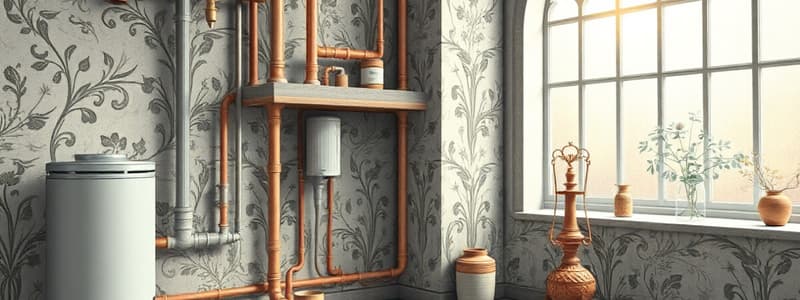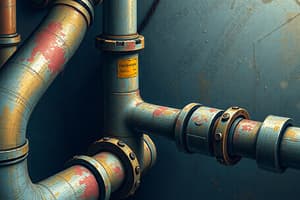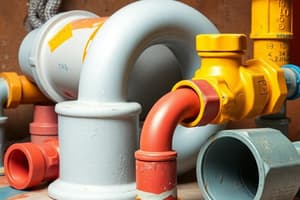Podcast
Questions and Answers
Which grades of copper are most commonly used in domestic heating systems?
Which grades of copper are most commonly used in domestic heating systems?
- R200 and R230
- R210 and R240
- R240 and R260
- R220 and R250 (correct)
What distinguishes R220 copper pipe from R250 copper pipe?
What distinguishes R220 copper pipe from R250 copper pipe?
- R220 is used for larger diameter pipes, while R250 is for smaller ones.
- R220 is half-hard straight lengths, while R250 is soft coiled.
- R220 is used in commercial installations, while R250 is for domestic use.
- R220 is soft coiled microbore, while R250 is half-hard straight lengths. (correct)
In a fully pumped system, what pipe sizes are typically used, excluding microbore systems?
In a fully pumped system, what pipe sizes are typically used, excluding microbore systems?
- 6mm and 8mm
- 10mm and 12mm
- 28mm and 35mm
- 15mm and 22mm (correct)
What is the primary advantage of using a microbore system in domestic heating setups?
What is the primary advantage of using a microbore system in domestic heating setups?
What is the function of a manifold in a domestic heating system using microbore pipes?
What is the function of a manifold in a domestic heating system using microbore pipes?
Which statement is correct regarding the installation of microbore systems?
Which statement is correct regarding the installation of microbore systems?
In what type of installations is Low Carbon Steel (LCS) most commonly used?
In what type of installations is Low Carbon Steel (LCS) most commonly used?
Why is it essential to include an inhibitor in systems that use Low Carbon Steel (LCS)?
Why is it essential to include an inhibitor in systems that use Low Carbon Steel (LCS)?
What characteristic makes plastic pipe, such as polybutylene, increasingly popular for plumbing installations?
What characteristic makes plastic pipe, such as polybutylene, increasingly popular for plumbing installations?
What property of polybutylene allows air to penetrate its walls, and how is this addressed in modern applications?
What property of polybutylene allows air to penetrate its walls, and how is this addressed in modern applications?
What is the primary function of insulation in the context of domestic heating systems?
What is the primary function of insulation in the context of domestic heating systems?
What role does foil play in some types of commercial insulation?
What role does foil play in some types of commercial insulation?
Why is choosing the correct insulation important for an appliance or pipe in domestic heating systems?
Why is choosing the correct insulation important for an appliance or pipe in domestic heating systems?
What type of insulation is commonly used for standard domestic installations to conserve fuel, power, and protect pipes from freezing?
What type of insulation is commonly used for standard domestic installations to conserve fuel, power, and protect pipes from freezing?
Which factor complicates the use of traditional stitched felt pipe insulation in older properties?
Which factor complicates the use of traditional stitched felt pipe insulation in older properties?
What materials are commonly used in the manufacturing of insulation for domestic heating systems?
What materials are commonly used in the manufacturing of insulation for domestic heating systems?
What is the recommendation for insulating pipes connected to a hot water vessel?
What is the recommendation for insulating pipes connected to a hot water vessel?
According to the provided content, what is the appropriate way to insulate secondary circulation pipes in a heating system?
According to the provided content, what is the appropriate way to insulate secondary circulation pipes in a heating system?
Besides energy savings, what additional benefits does insulation provide to domestic heating systems?
Besides energy savings, what additional benefits does insulation provide to domestic heating systems?
In the context of domestic central heating systems, where is it most critical to ensure pipework is insulated?
In the context of domestic central heating systems, where is it most critical to ensure pipework is insulated?
What property of polybutylene allows it to resist high temperatures and pressures, making it suitable for heating systems?
What property of polybutylene allows it to resist high temperatures and pressures, making it suitable for heating systems?
According to the materials listed for insulation, which one presents a fire safety concern in older properties?
According to the materials listed for insulation, which one presents a fire safety concern in older properties?
If a domestic heating system utilizes Low Carbon Steel (LCS) pipes, what maintenance practice is critical to prevent system failure?
If a domestic heating system utilizes Low Carbon Steel (LCS) pipes, what maintenance practice is critical to prevent system failure?
In a microbore system, how does the design of the manifold contribute to efficient heating?
In a microbore system, how does the design of the manifold contribute to efficient heating?
How does the smooth internal bore of polybutylene pipes contribute to the efficiency of a central heating system?
How does the smooth internal bore of polybutylene pipes contribute to the efficiency of a central heating system?
Flashcards
What are R220 and R250?
What are R220 and R250?
Copper grades commonly used in domestic heating systems.
What is R220 copper pipe?
What is R220 copper pipe?
Soft coiled microbore pipe (8mm and 10mm), sold in coils.
What is R250 copper pipe?
What is R250 copper pipe?
Half hard straight lengths (15mm, 22mm, and 28mm), sold in straight lengths.
What is Microbore?
What is Microbore?
A pipework system using small bore pipes (12mm, 10mm, 8mm, 6mm).
Signup and view all the flashcards
What is a Manifold?
What is a Manifold?
Connects flow and return pipes to individual radiators with small outlets.
Signup and view all the flashcards
What is Low Carbon Steel (LCS)?
What is Low Carbon Steel (LCS)?
A material rarely used in domestic installations, more common in commercial/industrial settings.
Signup and view all the flashcards
What is Polybutylene?
What is Polybutylene?
Material becoming popular for installations, easy to install with long lengths.
Signup and view all the flashcards
What is Insulation's primary function?
What is Insulation's primary function?
Insulation delays the cooling process; it doesn't fully prevent freezing.
Signup and view all the flashcards
What are the benefits of insulation?
What are the benefits of insulation?
Prevents heat loss/gain, reduces energy consumption & fuel bills.
Signup and view all the flashcards
What is a standard domestic pipe insulation?
What is a standard domestic pipe insulation?
Flexible polyethylene is commonly used, conserving fuel/power and preventing freezing.
Signup and view all the flashcards
What is traditional felt pipe insulation?
What is traditional felt pipe insulation?
Traditional stitched felt is used for economical protection of pipework under floors.
Signup and view all the flashcards
What materials are insulation made from?
What materials are insulation made from?
Stitch felt ,Polyethylene foam, Phenolic foam, Polyisocyanurate foam, PVC foam, Polystyrene, Nitrile rubber, Cellular glass foam.
Signup and view all the flashcards
When should the primary heating circuit be insulated?
When should the primary heating circuit be insulated?
Insulate whenever passing outside heated areas (e.g., lofts).
Signup and view all the flashcards
What are the advantages of insulation?
What are the advantages of insulation?
Saves energy, fuel bills, reduces CO2 emissions, improves temperatures, frost protection.
Signup and view all the flashcards
What is an advantage of using microbore pipe?
What is an advantage of using microbore pipe?
Contains less water so heats faster.
Signup and view all the flashcards
What does a manifold allow for?
What does a manifold allow for?
Can accommodate several radiators.
Signup and view all the flashcards
Name 4 things insulation does.
Name 4 things insulation does.
Saves energy, saves fuel bills, less CO2, better draw-off temperatures.
Signup and view all the flashcards
What traditional insulation is used effectively?
What traditional insulation is used effectively?
Protect pipework under floors.
Signup and view all the flashcards
On primary circuit.
On primary circuit.
Insulated throughout its length?
Signup and view all the flashcardsStudy Notes
- Materials used to install domestic central heating pipework
- Learners should be able to identify materials in plumbing, describe materials for insulation, and look at specific tools used in installations.
Copper
- Grades R220 and R250 are commonly used in domestic heating systems.
- R220 is soft coiled microbore pipe, available in 8mm and 10mm sizes and sold in 10 and 25 meter coils.
- R250 is half hard straight lengths, available in 15mm, 22mm, and 28mm sizes, and sold in 1, 2, 3, and 6 meter lengths.
Copper: Microbore
- R220 is commonly used as soft coiled microbore pipe in 8mm and 10mm.
- In fully pumped systems, 22mm and 15mm small bore pipe is often used.
- Microbore systems utilizing 12mm, 10mm, 8mm, and 6mm pipe are an alternative.
- 28mm or 22mm flow and return pipes are fitted with a manifold, which accommodates several radiators.
- Manifolds are adaptors with numerous small outlets allowing runs to individual radiators.
- Microbore systems contain less water, resulting in faster heating.
- Manifolds can be side entry or linear.
- Microbore pipes come in coils and are clipped to joists to avoid multiple joints.
- Connections are soldered, push fit, or compression.
Low Carbon Steel
- Low carbon steel (LCS) is rarely used in domestic installations but can be found in larger and older properties.
- LCS is commonly used in commercial and industrial installations.
- Heavy-grade LCS is red and used for steam and fire systems.
- Medium-grade LCS is blue and used for heating and oil lines.
- Light-grade LCS is brown and used for gas.
- Systems with LCS must have an inhibitor to prevent corrosion.
Polybutylene
- Plastic pipe is becoming increasingly popular for installations due to its ease of installation and ability to have long lengths without connections.
- Connections to boilers typically need to be made in copper.
- Heat emitter tails are often made of copper, with the carcass under the floor made of plastic.
- Polybutylene has high temperature and pressure resistance with a low noise transmission and thermal expansion.
- Polybutylene has a smooth internal bore, allowing for good flow rates, and it does not corrode like copper and LCS.
- Polybutylene is microporous, but newer pipes have an impermeable barrier for use in hot and cold water installations.
- Polybutylene pipes are available in 10mm, 15mm, 22mm, and 28mm diameters, with lengths of 3 meters, and coils of 25, 50, and 100 meters.
Materials: Insulation
- Insulation does not fully prevent freezing but delays the cooling process.
- Insulation stops cold from getting to the pipe and heat from leaving it.
- It is made up of pockets of still air.
- Commercial insulation uses foil to deflect heat or cold.
- Flexible polyethylene pipe insulation is commonly used, conserves fuel and power, and protects pipes from freezing for standard domestic installations.
- It complies with part L Building Regulations and meets water regulations.
- Traditional stitched felt pipe insulation is an economical and effective protection for pipework under floors.
- Stitched felt is not flammable, but original horsehair lagging is flammable, requiring caution when soldering in older properties.
- Stitch felt, polyethylene foam, phenolic foam, polyisocyanurate foam, PVC foam, polystyrene, nitrile rubber (expanded), and cellular glass foam are used to make insulation.
Insulation Guidelines
- The primary circuit for heating and hot water should be insulated whenever it passes outside the heated living space.
- The primary circuit for hot water should be insulated throughout its entire length.
- Pipes connected to the hot water vessel, including the vent, should be insulated for at least 1 meter from the point of connection to the vessel, or to where it becomes concealed.
- Secondary circulation should be insulated for the entire circuit.
- Insulation saves energy, reduces fuel bills and CO2 emissions, improves draw-off temperatures, keeps water warmer for longer, retains heat in the system, and provides frost protection.
Studying That Suits You
Use AI to generate personalized quizzes and flashcards to suit your learning preferences.




